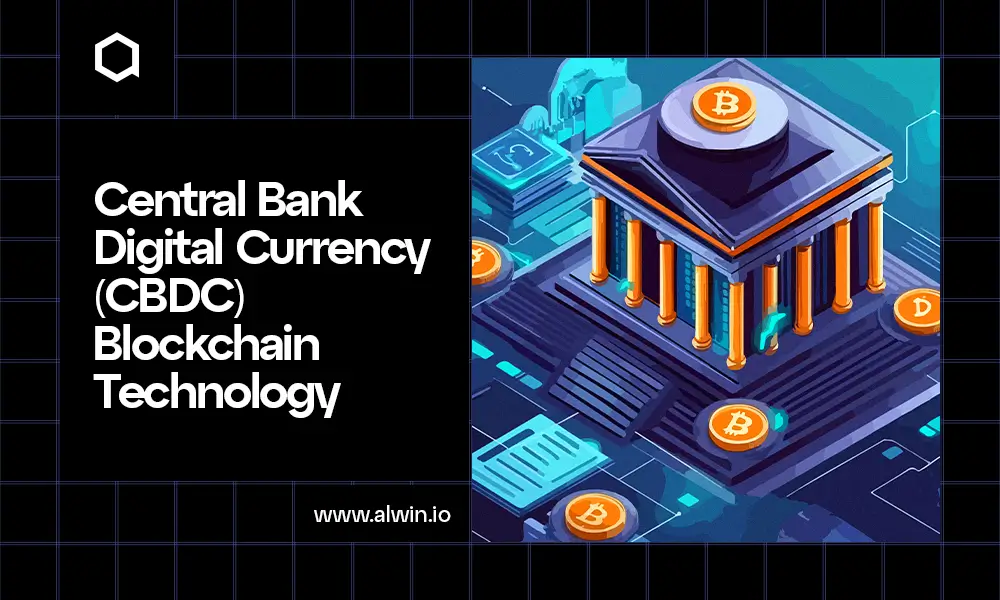Money is going digital, and fast. From swiping cards to scanning QR codes, the way we pay has already transformed. But now, we’re on the edge of an even bigger shift: Central Bank Digital Currencies (CBDCs) powered by blockchain technology.
No, this isn’t just about crypto or Bitcoin. This is about governments and central banks stepping into the digital age with official digital versions of their currencies, built on tech that ensures transparency, speed, and trust. It’s the fusion of financial authority with decentralized innovation.
In this blog, we’ll explore what CBDCs really are, how blockchain powers them, and why this combo could completely reshape how we think about money, banking, and economic stability. Whether you're a fintech fan, a curious investor, or just someone who wants to know what the future of currency looks like, you’re in the right place.
What is Central Bank Digital Currency (CBDC)?
A Central Bank Digital Currency (CBDC) is a digital version of a country’s official currency, issued and regulated by its central bank. Simply put, it’s money—but in digital form, backed by the government, just like physical cash.
Unlike cryptocurrencies like Bitcoin or Ethereum, which are decentralized and not controlled by any authority, CBDCs are fully centralized. They are created and managed by the central bank and represent legal tender, meaning they can be used to pay for goods, services, and debts, just like cash or traditional digital bank balances.
There are two main types of CBDCs:
Retail CBDC – meant for everyday people and businesses to use, similar to cash but in a digital wallet.
Wholesale CBDC – designed for financial institutions to settle large-scale transactions faster and more securely.
The goal of CBDCs is to modernize the financial system, making payments faster, cheaper, more secure, and more inclusive, especially in countries with limited access to banking services. Some central banks also see CBDCs as a way to reduce reliance on cash, combat financial crime, and enhance monetary policy control. CBDCs are the next step in the evolution of money, blending the trust of government-issued currency with the speed and convenience of digital transactions.
Why Central Bank Digital Currency (CBDC) has Incorporated Blockchain Technology?
Central Bank Digital Currencies (CBDCs) are being developed to modernize the way we use money, and blockchain technology plays a key role in making that possible. But why exactly are central banks turning to blockchain? Let’s break it down in simple terms.
1. Transparency and Trust
Blockchain provides a transparent and tamper-proof ledger of all transactions. For a CBDC, this means every transaction can be traced, verified, and audited in real time. It reduces fraud, enhances regulatory oversight, and increases public trust because the system is open, even if the users are private.
2. Security and Anti-Counterfeiting
Digital currencies need high levels of protection from hacking, fraud, and counterfeiting. Blockchain offers strong encryption and decentralized validation, making it extremely difficult for bad actors to manipulate the system or create fake digital money.
3. Real-Time Settlements
Traditional banking systems often involve slow settlement processes that can take hours or even days. With blockchain, CBDCs can benefit from instant transactions and near real-time settlement, improving efficiency for both domestic and cross-border payments.
4. Reduced Costs and Intermediaries
By using blockchain, central banks can cut down on intermediaries involved in the clearing and settlement of transactions. This streamlines the entire system, lowers operational costs, and reduces the burden on legacy infrastructure.
5. Programmable Money
Blockchain enables “smart” money. With programmable features, CBDCs can be designed to perform specific actions, like automating tax deductions, disbursing aid with usage restrictions, or enforcing compliance rules, without needing manual intervention.
6. Financial Inclusion
By building CBDCs on blockchain, central banks can reach unbanked and underbanked populations through mobile devices, even in areas without traditional banking infrastructure. This supports greater economic inclusion and digital participation.
7. Interoperability with Digital Ecosystems
Blockchain allows CBDCs to interact errorlessly with other digital platforms, including decentralized finance (DeFi) systems, payment gateways, and cross-border transaction networks. This makes CBDCs more flexible and future-proof.
Central Bank Digital Currency and Blockchain Technology – How it Benefits People?
The fusion of Central Bank Digital Currency (CBDC) and blockchain technology isn’t just a win for governments and financial institutions—it brings powerful benefits directly to everyday people. As more countries explore or roll out their digital currencies, backed by blockchain, the real game-changer is how it reshapes daily financial life for millions.
Faster, Cheaper Payments
Say goodbye to delays and high fees. CBDCs powered by blockchain enable instant, low-cost transactions, whether you're paying a local shop, sending money abroad, or settling bills. No need to wait hours—or days—for a transfer to process. It’s faster, simpler, and much more efficient.
24/7 Accessibility
Unlike traditional banking systems that operate on business hours, CBDCs on blockchain are available 24/7. That means you can send, receive, and access your money anytime, anywhere—even on weekends and holidays. It’s financial freedom that fits your lifestyle.
Increased Financial Inclusion
For people in rural areas or regions with limited access to banks, a CBDC offers a major breakthrough. All you need is a smartphone or digital wallet to participate in the economy. Blockchain-backed CBDCs open up banking to the unbanked, making financial services more inclusive and accessible.
Improved Clarity and Confidence
Blockchain keeps a secure, tamper-proof record of every transaction. This means greater transparency for users, reduced fraud, and stronger consumer protection. You’ll know exactly where your money is going and be able to track it securely.
Safer Digital Money
CBDCs are government-backed and regulated, giving users the stability and trust of a national currency, unlike unregulated cryptocurrencies. Plus, blockchain adds top-tier encryption and protection against hacking and counterfeiting.
Easier Aid and Stimulus Distribution
In times of crisis, like pandemics or natural disasters, CBDCs can help governments distribute financial aid instantly and directly to citizens, with full traceability. No middlemen, no lost funds—just fast, transparent support when people need it most.
More Control Over Your Finances
With blockchain integration, users can manage their funds, set payment rules, and even participate in smart contract-based financial services, like automatic bill payments or programmable savings, giving them more control over their financial lives.
CBDCs powered by blockchain technology aren’t just about going digital—they’re about making money work better for everyone. From speed and security to inclusion and transparency, this tech duo is laying the foundation for a more open, efficient, and user-friendly financial future.
CBDC – Future Predictions for the Digital Currency Revolution
Central Bank Digital Currencies (CBDCs) are no longer just experimental concepts—they’re quickly becoming the future of national financial systems. As more governments, economists, and tech leaders recognize their potential, the coming years are expected to bring major shifts in how CBDCs are used, regulated, and adopted worldwide.
Here’s a look at what the future of CBDCs might look like:
1. Global Adoption Across Major Economies
By 2030, it's predicted that over 80% of central banks will have either launched or piloted a CBDC. Countries like China, India, the EU, and even developing nations in Africa and Latin America are actively pushing forward. As international standards evolve, we may even see interoperable CBDCs—currencies that can easily interact and exchange across borders.
2. Replacement or Reduction of Physical Cash
While cash won’t disappear overnight, CBDCs will likely reduce the dependence on physical currency over time. With contactless payments becoming the norm, digital wallets powered by CBDCs will offer a more convenient and secure alternative—especially in urban and tech-savvy regions.
3. Strengthened Financial Inclusion
One of the biggest benefits of CBDCs in the future will be their ability to reach unbanked populations. As mobile access expands, people in rural or underbanked areas will be able to participate in the economy using just a smartphone—no traditional bank account required.
4. Enhanced Government Efficiency
Expect CBDCs to transform how governments manage finances. From real-time tax collection to faster public benefit distribution, the integration of programmable digital currencies will make public services smarter, faster, and more transparent.
5. Integration With Emerging Technologies
CBDCs will likely integrate with AI, IoT, and smart contract systems, enabling automated payments for connected devices (like paying your electricity bill automatically) or programmable money that can be used only for specific purposes (like subsidies or grants).
6. Growth in Cross-Border Transactions
Today, sending money internationally is slow and expensive. CBDCs are expected to enable near-instant, low-cost cross-border payments, bypassing traditional banking delays and fees. This could drastically improve international trade, remittances, and global financial inclusion.
7. Evolution of Privacy and Regulation
As CBDCs grow, so will concerns around data privacy and surveillance. Future CBDC systems are expected to strike a balance between regulatory control and user privacy—possibly through tiered levels of anonymity, depending on the transaction size or type.
8. Competition With Stablecoins and Cryptocurrencies
CBDCs may coexist or compete with private cryptocurrencies and stablecoins. However, being government-backed, CBDCs will likely dominate in regulated sectors like payroll, taxes, and institutional finance, while private tokens might continue thriving in DeFi and community-based ecosystems.
Final Thoughts: A New Era of Digital Finance
CBDCs represent more than just digital money they're the foundation of a more inclusive, transparent, and programmable global economy. As technology, trust, and infrastructure continue to align, CBDCs are set to reshape how we think about value, transactions, and national economies for decades to come.



